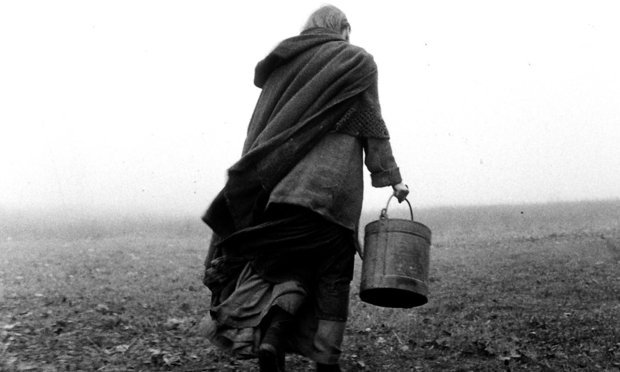
The Turin Horse, a Crafted Storyboard of Angelic Light
Slow the gears way down and go back to cinematography 101. Back to the mesmerizing glow on the actor’s face and the fine balance of light against a pallet of gray shadow. Where film has come to worship color enhancement and quick cuts, I think we’ve underestimated the strength of static-frames and the black-and-white image. This is proven by Bela Tarr‘s Hungarian film, The Turin Horse, with cinematography by Fred Kelemen (interviewed here). A magnificent mix of the still and moving camera shot, The Turin Horse uses as little as 30 cuts to recreate an 1889 home in the isolated plains of Turin, Italy. The fictional tale continues a historical moment in which the German philosopher, Friedrich Nietzche, was said to have flung his arms around a cab horse being whipped by its owner. The audience, however, isn’t given a reenactment of Nietzche’s breakdown-inciting episode; rather, the story begins with the philosopher horse and his owner returning home through the treacherous Italian wind, where they remain immobile during a six-day storm. Two hours worth of little to no dialogue, the trying times of a cab driver and his daughter are slowly engrained in our eyes and ears using richly lit angles and the repetition of waking, fetching water from the well, dressing for work, harnessing the horse, dressing for rest, boiling the potatoes, repeat! Though the prolonged scenes may be a treatment at times, The Turin Horse is a crafted storyboard of angelic light, made for the patient and the sympathetic viewer.
Tarr’s long shots are a trademark of his latest film, but more so, the use of space and shadow slap a label of cinematography on practically every frame. Within the crafted light and dark there appears a captivation of poverty. Imagine this: you’re walking through an Italian museum and the first photo you come upon is an 17th-century Turin house with uneven brick, a rotting wood door, and an expressionless woman staring out a window. A fierce storm blurs the otherwise perfectly framed and lit moment. You can practically hear the cold wind howl, but then you really do hear it and you see the sweeping dust and you swear the woman’s eyes are blinking. Though a film, the experience for the audience feels like a study of still imagery. These are Tarr’s golden moments, visual subtext at its best, for the despair is given in shades of gray in lieu of dialog-based acting. If paused, the frame can stand for a work of art, like the daughter standing over a flaring stove, or the wide shots of a steaming bowl, or the bird’s-eye-view of the empty well. And though the actions repeat, the choice of camera angles do not. On the first day, you might watch the girl dress her father from a side angle, then on the third day from a front angle then perhaps on the sixth day from a lower angle. The survival of the Italian father and daughter invokes a slow-earned concern that the viewer can’t quite articulate.
http://www.youtube.com/watch?v=v32n4lCG0OA&feature=related
The endurance needed to follow this repetition is significant. The point, however, is not to give away answers, it is the viewer’s job to create subtext and context. The simple plot points, such as the encounter with passing gypsies or the brief evacuation of the farm, are added conflicts which the characters must overcome before they proceed with their routine. It is nice though when the organs and strings of the thematic score enhance the more subtle climaxes: the horse’s failing health (their means of livelihood) and their loss of water. The pace of the movie is also driven by a heavy dialogued scene, where a neighbor proceeds to share his beliefs of the human condition and the suffering of their town. So unexpected is this bombardment of words that it takes a while for the brain to switch over to audio and read the subtitles as they appear at the bottom of the screen. As he speaks, the camera zooms closer and closer to the neighbor’s face until the cart driver, who has been listening with his daughter, deems the neighbor’s speech absurd. The neighbor then grunts and walks out, leaving his words suspended in the doomed household.
What we take away from the elongated silences and mundane expressions is a desire to live beyond routine, even when death approaches. The hours spent with The Turin Horse is well prescribed and you leave the theater feeling wiser and honored to have been exposed to Tarr’s world. Years from now, the blacks and whites of this film will be a memory of patient curiosity and respect to a tragic view of humanity.
